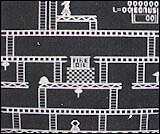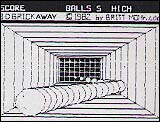FOUR GREAT GAMES FOR
THE COLOR COMPUTER
BY OWEN LINZMAYER
|
DOODLE BUG
In Doodle Bug, you move a hungry ladybug through a maze lined with dots while avoiding the predatory insects. Sounds a lot like Pac-Man, right? Well it is, and it isn't. The main difference between Pac-Man and Doodle Bug is that the former doesn't have rotating turnstiles. And what a difference they make!
Doodle Bug is an adaptation of LadyBug, a coin-op arcade game by Universal. The object of Doodle Bug is to clean out maze after maze of dots. There are other special elements scattered randomly in the corridors that can bring extra points of death. These include: hearts, letters, and skulls.
Doodle Bug is controlled with the joystick, and responds remarkably well to the slightest movement of the stick. After you have the game loaded and running, you never have to touch the keyboard unless you want to freeze the action, or abort the game in play.
One thing I really like about Doodle Bug is that the computer screen actually looks like a real arcade game, rather than a computer adaptation. Doodle Bug features four colors, and the highest resolution graphics I have seen on any Color Computer game. The graphics are very detailed, but the animation of the bugs is slightly jumpy.
One or two people can compete for high scores. Using the right joystick, you choose the number (3-6) of ladybugs with which you wish to begin in the game. This allows for both long and short games.
David Crandall, author of Doodle Bug, has done an excellent job of converting LadyBug to the Color Computer. The only change I would like to see made would be to have the aggressive bugs become quicker as the game goes on as they do in the arcade game. As it stands now, the speed of all of the elements remains constant throughout the game. Nevertheless, Doodle Bug is challenging and a very good buy.
|
DONKEY KING
In the world of arcade games, 1982 was the year of Donkey Kong. Virtually no computer or home video game system is without a program that resembles the original coin-op game. Now, from Tom Mix Software, there is Donkey King for the TRS-80 Color Computer.
After evaluating many programs that run on the TRS-80 Color Computer, I had concluded that, at best, the Color Computer was capable of playing only mediocre games; programs of redeeming entertainment values were few and far between. But Donkey King has changed all that. It is absolutely the best arcade game written for the Color Computer.
In Donkey King, as in Donkey Kong, you portray Mario the Jumpman. It is your mission to rescue your girlfriend from the sinister clutches of a nasty ape. In your struggle to succeed, you must scuffle about on metal skyscrapers, jump elevators, and avoid fireballs. The path to the top is a hard one indeed.
Donkey King takes up a tremendous amount of memory (32K). This is because it has all four screens, like the original coin-op game, in one large program. The popular ColecoVision cartridge of Donkey Kong has only the first three screens. Not only does Donkey King have all of the boards, it presents them in the same sequence in which they appear in the coin-op game.
One or two players can compete, alternating turns. There are two game modes: regular and practice. If you choose the standard game, you begin with three men at your command. The practice mode gives you 12 lives. This may seem like a lot, but believe me, they sure don't last long.
The screens are almost identical to those of Donkey Kong, and the game plays similarly. Moving your joystick causes Mario to move around, and pressing the action button makes him jump in the direction he was running. Donkey King is one of the only Color Computer games that effectively uses the unfortunate Radio Shack joystick controllers.

|
The graphics of Donkey King are hi-res and about as colorful as any Color Computer game on the market. The animation of the elements is very professional--everything moves smoothly with very little flickering.
Donkey King has everything the arcade game has except an "insert coin" message. The sound effects are very good for the Color Computer, and every audio effect of the video game has been woven into this impressive program.
The one complaint I have about the game is that it becomes far too difficult too quickly. I have played many games in the practice mode, and rarely do I get to the fourth and final board (keep in mind that you get 12 men in the practice mode). The program would be greatly enhanced by selectable difficulty levels. As it stands, you often feel that your demise was not the direct result of your actions, but rather of the cruelty of the program.
It is difficult for me to communicate just how impressive Donkey King is. If I had to pick one program to show off the Color Computer, Donkey King would be it. If you call yourself a serious gameplayer, you can't afford to be without Donkey King--it alone sits on the game software throne.
|
STARFIRE
Starfire is a colorful machine language game that combines hi-res graphics and interesting sound effects to create a very playable Color Computer version of the popular arcade game Defender. For the benefit of anyone unfamiliar with Defender, a brief description is in order.
In Starfire, as in Defender, you guide a multi-directional space fighter over the surface of an alien planet. Your goal is to protect the helpless people who pepper the planet's surface.
Although the packaging of the software is rather poor, it does not reflect the quality of the game itself. Included with the tape or disk is a single page of documentation which describes the controls, explains loading instructions, and gives strategy hints.
Starfire uses keyboard controls. Some of the other Color Computer versions of Defender I have seen use the joystick and all of them are much more difficult to control. If a coin-op game uses buttons, then the computer adaptation should use the keyboard, rather than the imprecise Radio Shack joysticks. The only problem with the keyboard controls is that the up and down keys (2 and Z) are too far apart.
The screen consists of three separate displays. In the upper left-hand corner is the score box. In addition to the onscreen scoring, there is a graphic display of the number of ships and smart bombs you have left. Located in the upper right is a small radar screen to help you plan your assault on the aliens before they show up on your viewer.
The main portion of the screen is devoted to the playfield. On the playfield you see your ship, the ground below, and any invaders that happen to be within firing distance. The scrolling of the landscape is extremely smooth and the alien movements are equally non-jumpy.
Starfire is an excellent adaptation of Williams's arcade classic. If you enjoy Defender, then this program is for you. I am pleased to report that Starfire is one of the first programs that uses all of the neat functions of the TRS-80 Color Computer. I hope that Intellitronics will introduce more games of this high standard. I truly enjoyed "reviewing" this game, and I suspect you will be equally pleased.
|
3-D BRICKAWAY
Soon after joining the local YMCA last year, I took up a new sport, racquetball. Ever since I began playing, I have wondered if it would be possible to write a computerized game of racquetball. My question has been answered. 3-D Brickaway is a variation of Breakout that is very similar to a single-player racquetball game.
The computer screen shows a three-dimensional view of five walls. The wall at the far end of the court is broken up into 40 tiles that must be knocked out. You begin each game with five balls. Pressing the fire button on the joystick places a ball into play.
As the ball travels downcourt, its size decreases, giving the illusion of depth. When the ball hits a wall, it bounces off at logical angles. If the ball strikes a filled-in portion of the back wall, that tile is knocked out.
To hit the ball, you must manage to keep it in sight through the racquet. If you can do this, you will never have a problem returning the ball. There are two ways to hit the ball: simple deflection and power hit. A simple deflection occurs when the ball hits the paddle and bounces off wildly. For a power hit, you must have the fire button depressed. If you do this, you have more control of the ball, but its velocity increases.

|
The graphics in 3-D Brickaway are high-resolution, but not very colorful. The movement of the ball is not as smooth as it could be; this is a case in which graphics were sacrificed for playability. The paddle responds quickly to the joystick controls, allowing you to get from one corner of the screen to the other in the blink of an eye.
3-D Brickaway is more than a game, it is an example of how three-dimensional graphics can be used on the Color Computer. The excitement of racquetball is lost in the translation from YMCA to computer screen, but 3-D Brickaway is still a fun game to play and it is very reasonably priced.